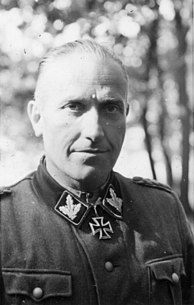This article is being considered for deletion in accordance with Wikipedia's deletion policy. Please share your thoughts on the matter at this article's entry on the Articles for deletion page. Feel free to improve the article, but the article must not be blanked, and this notice must not be removed, until the discussion is closed. For more information, particularly on merging or moving the article during the discussion, read the guide to deletion. |

The service record of Reinhard Heydrich was a collection of official SS documents maintained at the SS Personnel Main Office in Berlin from 1934 until the fall of Nazi Germany in 1945. Most of Reinhard Heydrich's record was captured by the Allies and used for subsequent investigation into Heydrich's duties as head of the RSHA and overall performance in the SS in general.
The SS Personnel Main Office was responsible for the administration of personnel matters regarding all leaders and officers of the Schutzstaffel (SS) of Nazi Germany. This included the Allgemeine SS, Waffen-SS and Sicherheitsdienst, specifically those matters regarding admission, promotion and dismissal, but also organisational matters, transfers, and training. It was responsible for processing recommendations for decorations. The office was also responsible for the SS seniority list (Dienstaltersliste), the granting of the SS-Ehrenring and Degen, and also appointed members within the Allgemeine SS. The chief of the office was SS-Gruppenführer Walter Schmitt until 1942, followed by SS-Obergruppenführer and General of the Waffen-SS Maximilian von Herff. The office was supervised closely by the Reichsführer-SS Heinrich Himmler.

Berlin is the capital and largest city of Germany by both area and population. Its 3,723,914 (2018) inhabitants make it the second most populous city proper of the European Union after London. The city is one of Germany's 16 federal states. It is surrounded by the state of Brandenburg, and contiguous with its capital, Potsdam. The two cities are at the center of the Berlin/Brandenburg Metropolitan Region, which is, with 6,004,857 (2015) inhabitants and an area of 30,370 square km, Germany's third-largest metropolitan region after the Rhine-Ruhr and Rhine-Main regions.

Nazi Germany is the common English name for Germany between 1933 and 1945, when Adolf Hitler and his Nazi Party (NSDAP) controlled the country through a dictatorship. Under Hitler's rule, Germany was transformed into a totalitarian state that controlled nearly all aspects of life via the Gleichschaltung legal process. The official name of the state was Deutsches Reich until 1943 and Großdeutsches Reich from 1943 to 1945. Nazi Germany is also known as the Third Reich, meaning "Third Realm" or "Third Empire", the first two being the Holy Roman Empire (800–1806) and the German Empire (1871–1918). The Nazi regime ended after the Allies defeated Germany in May 1945, ending World War II in Europe.
Contents
- Naval career
- Summary of SS career
- The early years
- Nazi Germany
- Peacetime
- Wartime
- Career's end
- Service as fighter pilot
- Possible late war assignments
- Dates of rank
- Reichsmarine
- SS
- Awards and decorations
- Awards portrayed in fiction
- Notes and references
Today, Reinhard Heydrich's original paper service record is maintained at the German Federal Archives. A microfilm copy of the record is also available at the National Archives and Records Administration in College Park, Maryland.
A service record is a collection of either electronic or printed material which provides a documentary history of a person's activities and accomplishments while serving as a member of a given organization. Service records are most often associated with the military, but are commonly found in other groups, such as large corporations or for use by employees of a civilian government.

The German Federal Archives or Bundesarchiv (BArch) are the National Archives of Germany. They were established at the current location in Koblenz in 1952.

The National Archives and Records Administration (NARA) is an independent agency of the United States government charged with preserving and documenting government and historical records and with increasing public access to those documents, which comprise the National Archives. NARA is officially responsible for maintaining and publishing the legally authentic and authoritative copies of acts of Congress, presidential directives, and federal regulations. The NARA also transmits votes of the Electoral College to Congress.









